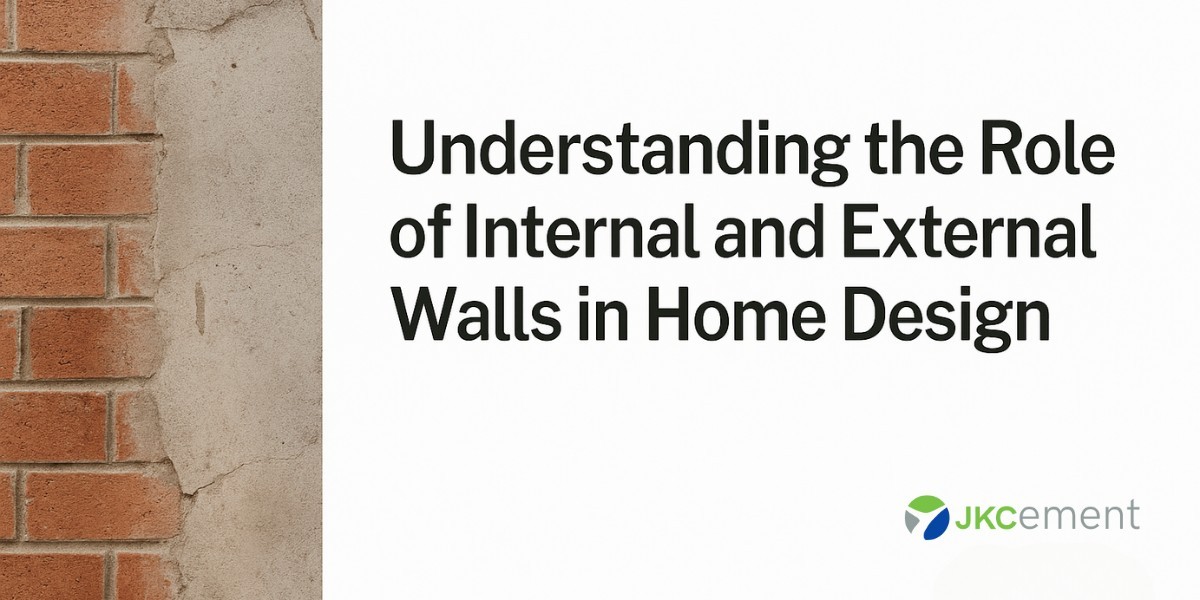Behind Every Strong Home, some Walls Do More Than Divide
When we think of walls, we often picture surfaces to paint, hang artwork on, or maybe mount a TV. But in construction, walls are more than partitions — they’re the very bones of a building.
From bearing the load of the structure to insulating rooms from heat and sound, every wall — internal or external — plays a silent, critical role.
At JK Cement, where strength and design go hand in hand, we believe understanding the types of walls is key to building smarter homes.
Let’s break it down.
What Are Internal and External Walls?
Internal Walls
Also called partition walls, these divide the interior into rooms. They’re non-load-bearing (mostly) and can be built with brick, block, concrete, or even lightweight panels like gypsum boards. Their role is more about privacy, space separation, sound insulation, and aesthetics.
External Walls
These are the outer walls of the building. They’re typically load-bearing, designed to support the roof, resist wind loads, and protect from external elements like rain, heat, and cold.
Types of Internal Walls (With Use Cases)
1. Brick Partition Walls
Common in residential buildings. They’re sturdy and provide a certain degree of soundproofing.
Ideal for: Bedrooms, kitchens, and storerooms.
2. Gypsum or Drywall Partitions
Lightweight and quick to install. Often used in modern apartments and offices.
Ideal for: Creating temporary cabins, study rooms, or wardrobes.
3. Glass Partition Walls
Used where light and openness are desired. Framed or frameless, they’re aesthetic but not soundproof.
Ideal for: Office cabins, living-dining dividers.
4. Concrete Partition Walls
Rare in homes but common in commercial buildings where fire resistance is a factor.
Ideal for: Industrial or commercial interiors.
Types of External Walls (And Why They Matter)
1. Load-Bearing Brick or Block Walls
Traditional yet reliable. With proper plastering and curing, they’re strong and long-lasting.
Used in: Independent homes, low-rise buildings.
2. Reinforced Concrete Walls (RCC)
Used when the structure has to bear heavy vertical and lateral loads.
Used in: High-rise apartments, earthquake zones.
3. Cavity Walls
Two parallel walls with a gap in between to enhance insulation and waterproofing.
Used in: Cold regions or luxury homes for thermal efficiency.
4. Precast Concrete Panels
Speed up construction and are energy-efficient. Also allow for modular expansion.
Used in: Commercial buildings, mass housing projects.
Real Site Talk
?️ “In Bhopal, we once had to rebuild a wall that didn’t follow soil-specific load guidelines. That one mistake cost the client months. Choosing the right wall type isn’t just about design. It’s about long-term safety,”
— Rajeev Mehta, Site Engineer, JK Cement Project Team
Why External Walls Are Crucial in Indian Climates
In a country like India, where temperatures swing from -2°C in Shimla to 45°C in Nagpur, external walls do more than protect — they regulate temperature. Walls made using the right plaster mix, thermal insulation, and cement strength (like JK Super Cement) can significantly improve energy efficiency and indoor comfort.
? JK Cement’s Role in Stronger Walls
Whether it's:
Load-bearing RCC walls
Partition panels
Durable external plaster mixes
Or moisture-resistant putty for long wall life...
JK Cement’s wide range of construction materials is engineered for Indian conditions. Trusted by contractors, masons, and homeowners, we help lay the groundwork for homes built to last.
? FAQs on Wall Types and Design
1. What is the difference between internal and external walls?
Internal walls divide the inside space. External walls form the structure’s boundary and often bear load.
2. Are all external walls load-bearing?
Most are, but in some modern construction methods (like RCC framed structures), even external walls can be non-load-bearing.
3. What’s the best wall material for sound insulation?
Dense materials like concrete or double brick walls. Drywalls with insulation boards are also effective.
4. Which wall type is best for Indian homes?
Brick and block walls with proper cement plaster remain ideal for durability and weather protection.
5. Can I remove an internal wall during renovation?
Only if it’s non-load-bearing. Always consult a structural engineer before modifying any wall.
6. Are cavity walls suitable for Indian homes?
Yes, especially in areas with extreme climate or high rainfall. They improve thermal and moisture performance.
7. What type of wall is used for partitioning a flat?
Drywall or gypsum panels are commonly used for quick, lightweight partitioning.
Closing Note
Walls hold up more than ceilings — they hold up comfort, privacy, style, and safety. Whether internal or external, their selection must consider not just aesthetics, but function, climate, and long-term strength.
And when you choose trusted materials like JK Cement, you’re not just building walls — you’re building homes that stand the test of time.






